|
Another interesting photo received
from our Forums Sleuth, Mark Dawber
(New Zealand),
from a forum of old photos asking for information on the make of vehicle?
Seems the photo is from a New Zealand newspaper of 1919 showing a car
decorated to represent Canada for the peace celebration parade in Dunedin,
southern island. Three men and a boy are dressed in fur clothing. Beside
the car is a sled. The car is French, a cca 1913 De Dion Bouton EK
Two-seater 4cyl 1641 9CV 55kph.
Interesting immediate comeback from Mark was that
because the vehicle is representing Canada in the New Zealand Parade, it
has been suggested it could have been a 'Russell Motor Car' which was made
in Toronto, Canada. After further investigation, - indeed, from the front
the radiator shape and detail is quite remarkably similar. The Russell therefore requires investigation.
|
|
The Canada Cycle and Motor Company (CCM) had been making bicycles from
1899 and, being an amalgamation of a number of Canadian bicycle making
companies, it was quite successful. However, the downturn in the bicycle
market in the early 1900s prompted them to purchase the failing Canadian
Motors Ltd and go into production of cars also. CCM hired Tommy Russell as
General Manager.
We have no information as to whether Tommy Russell is a long-lost Canadian cousin of
our SVVS Publicity Officer Tony Russell, because the similarities are entirely
absent. Borne 1887, son of a shorthorn cattle breeder, academically gifted, keen
sportsman and graduated top of his class with BA in political Science, he
applied and became executive secretary of Canadian Manufacturing
Association at the central office in Toronto. His abilities were soon
spotted, and he was offered a management job at a meat packing firm, but
this was no to his liking as he would have to have worked at an abattoir.
He has a preference for engineering, and a distinct like for motor
vehicles, so he did subsequently accept a new job from one of his mentors
as manager of Canada Cycle & Motor Company (CCM).
He was subsequently sent traveling widely troubleshooting in Europe including England and
extensively in the Antipodes pruning their activities there, and within a
year he had reduced CCM public liabilities and turned a loss into profit.
While retrenching, he was able to persuade the board to use the dormant
Canadian Motors Ltd to manufacture vehicles. Early vehicles included
petrol engined Quadricycles for the Toronto Post Office in 1901 (below
left), but this was not a great success as it was vastly underpowered and
not weatherproof.
|
|
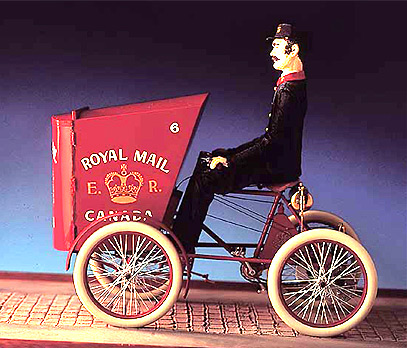
|
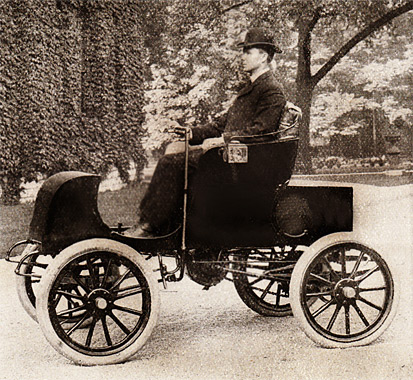
|
|
In 1903 they began manufacturing the two-seater 'Ivanhoe' electric
car (above right, shown with Tommy Russell driving).
Production of the Ivanhoe lasted for two years, until the internal
combustion engine began to gain popularity. Russell in the meantime was
developing a car suited to Canadian driving conditions, with wheels spaced
to fit wagon ruts on country roads. During the early years the company
also had sole Canadian distribution rights for Locomobile, Packard,
Peerless, Rambler, Winton and other U.S. automobiles.
In 1905, CCM produced the first 'Russell' car from the Russell Motor Car
Co, with Tommy Russell as President. The Russell vehicles quickly
developed a reputation as well-built and engineered cars, and the success
enabled Russell to focus on the high-end market. The Russell car
is considered by many as Canada's first practical automobile and one of
the best. Sales offices were opened in England, Australia and New Zealand
to distribute the output.
The Model A Runabout in 1905, had a 12 HP water cooled two opposed
cylinder petrol engine for $1,500. In 1906 they added the Model B at 16Hp
and a four-cylinder 24HP Model C at $2,600. 1907 produced the 18HP Model D
two cylinder and Model E four 15HP and Model F 40HP for $3750. !908 Model
G was a 18HP 2 two cylinder, and Model H a 30HP four, and Model K a 50HP
four at $5500, as well as a smaller 24HP four Model L at $2000. 1909
introduced the "Eighteen" Model G at $1600, and continued with
the Models 30 H Type, 50 K type and Model L at 24HP. Also at this time
they changed shape of the radiator to the more conventional central peaked
sloping type. All Russells had 14 spoke wheels back and front and none had
a bulkhead petrol filler cap. By 1910 Russell Motor Co Co was producing
everything from buses to delivery and fire trucks.
|
|
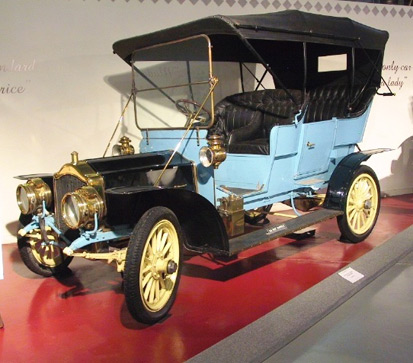
|
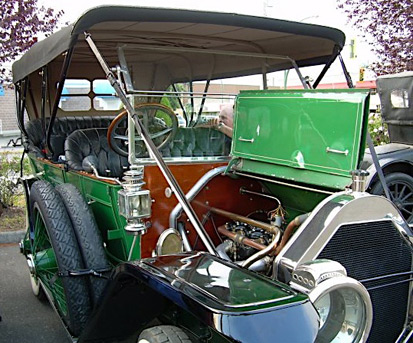
|
|
So is "our car a Russell? Our car (below left) has a bulkhead petrol filler cap and has a
10 spoke front wheel. The only model in the Russell range that could
possibly be considered as 'possible' was the 18 Roadster (below right), being the only
one with 10 spoke front wheel; - but this already had the standard sloping
rad and did not have the bulkhead filler cap. In view of the overall feel
of the car being wrong, we cannot suggest a Russell as a contender.
Subsequent consultations with our veterans expert Ariejan Bos, confirmed
" No doubt here, a De Dion-Bouton, probably a 1913 9CV.
|
|
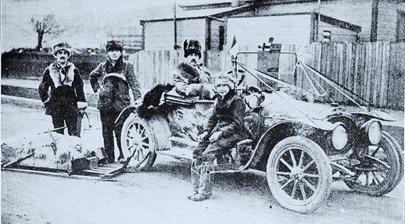
|
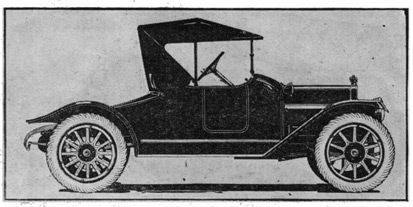
|
|
Russell company subsequently used the Knight Sleeve valve engine in their
cars, negotiated with Daimler of England, and like other Knight users
experienced difficulties with it. With these difficulties with the engine
and with the rapidly looming World War One, Russell car production was
joint-ventured with Willys Overland in 1916, Tommy Russell President in
1915.
Tommy Russell was an anglophile, having frequently visited the UK,
and was instrumental in outfitting the Canadian Expeditionary Force with
specialist vehicles and war equipment making the first 'Canadian Contingent'
equipped with some of the most efficient mechanical transport and support
in the British army. During WW1 Russell Company in Canada was
manufacturing ammunition for the British War effort. After the war the
company continued as general engineers into the 1950s. In the final decade
of his life Tommy Russell served as President of Massey Harris (Massey
Ferguson).
Summarising, the car in our top picture is NOT a Russell but a cca 1913 De Dion-Bouton
Torpedo Two Seater, probably the 9HP.
|
| PREVIOUS
ENQUIRES ON OUR HELP PAGES ON TH RUSSELL MAKE |
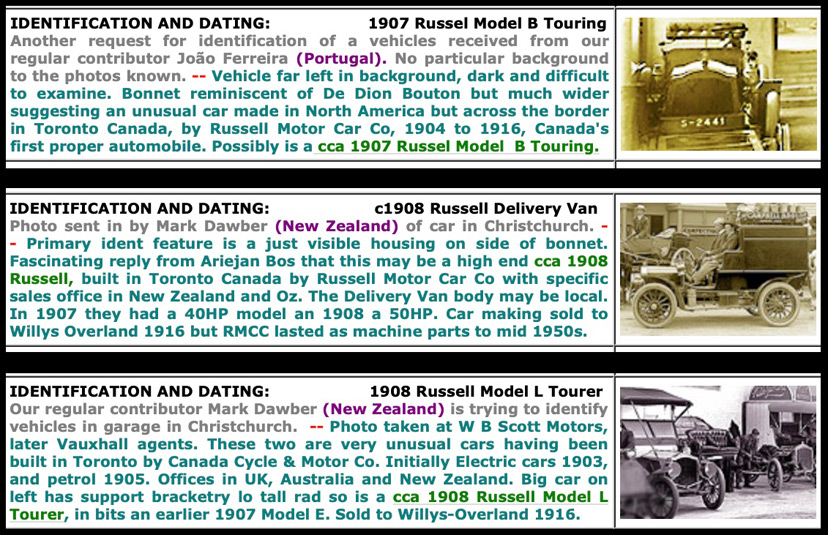 |
| |
|
Go to Recent Venues Page
PICTURE GALLERY INDEX
|